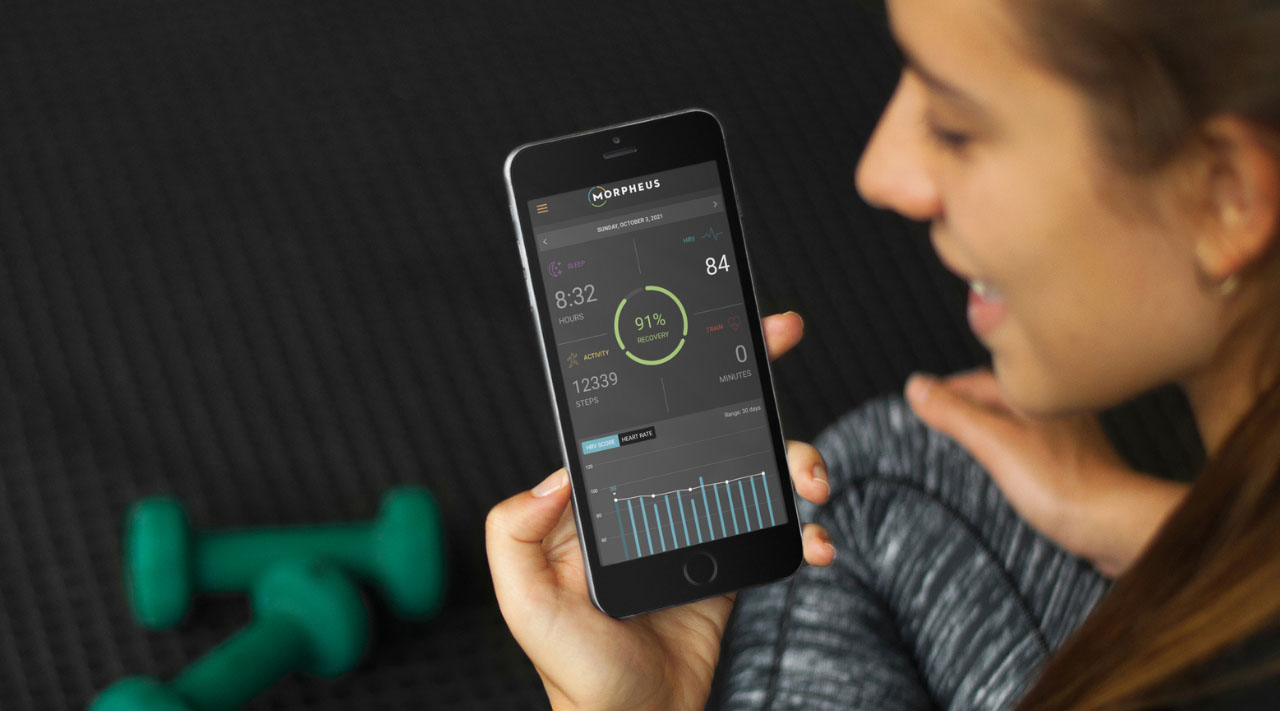
After 20 years of using HRV, if there’s one thing I can say with absolute certainty, it’s that when used effectively, it’s an invaluable tool for improving your conditioning.
In my experience, it’s the “effectively” part where most people struggle. They’re not quite sure how to actually use the information that HRV is giving them.
They’ve never been given a complete picture of exactly what HRV is other than just another number.
Note: If you need a quick primer on what HRV is, the basics of how it works, and how to measure it accurately click here
The thing about HRV is that yes, it’s just a single number. But it’s one that can be incredibly powerful when you look at it through the right lens.
The reason it can be so powerful is because it’s not just telling you how many times your heart is beating in a minute or how many steps you took yesterday.
There are a lot of ways to track what you’ve already done, but only HRV can help you make smarter, better-informed, decisions about what to do next.
It can do that because when you know what to look for, HRV tells you an important story about your body. It’s a story that you need to know and understand if you want to get the most out of your training.
If that’s your goal then stick with me. I’m going to show you exactly how HRV can be used to train smarter, recover faster, and improve your conditioning in record time.
The importance of dialing in the right intensity
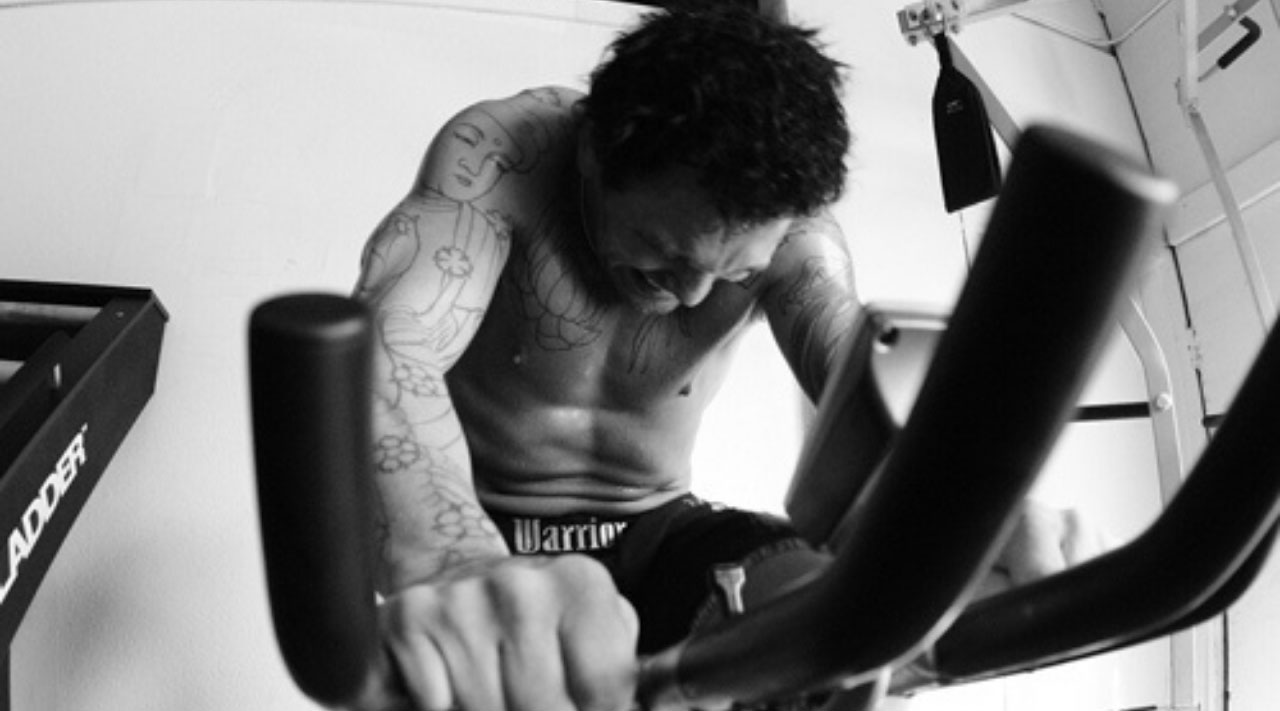
To understand how HRV can help you dial in the right intensity each day, the place to start is to recognize that everything about your fitness, health, and wellness is nothing more than the cumulative sum of your decisions.
That’s because each and every day, whether you realize it or not, you make a lot of decisions that directly impact how your body looks, feels, and performs.
Day in and day out, you are faced with answering questions like:
- How hard should I train today?
- How many calories should I eat?
- Which foods should I get those calories from?
- How many hours of sleep do I need?
- What exercises should I do?
- I feel kind of tired, should I take the day off?
- Am I making any progress?
Whether you put a lot of time into thinking about the answers or you just go through your day on auto-pilot, the decisions you make each day are ultimately what determine the path your fitness takes.
Using HRV is the single best tool there is to help you make the best decisions, because it gives you invaluable insight into where your body is at. The truth is that without that insight, you’re mostly just guessing.
So, how do you use HRV to make smarter decisions and get faster results?
Well, when it comes to training each day, the most important question to ask yourself is, “How hard should I train today” instead of, “How hard can I train today?”
This is where HRV can help give you the answer. If you look at your HRV not just today, but over the last few days, then you can get a very good idea of how much total stress you’ve been under.
Generally speaking, the bigger the jumps in your HRV, both up and down, the more energy your body has been expending dealing with stress and recovery.
You can see an example of this below from my Morpheus Coach platform.
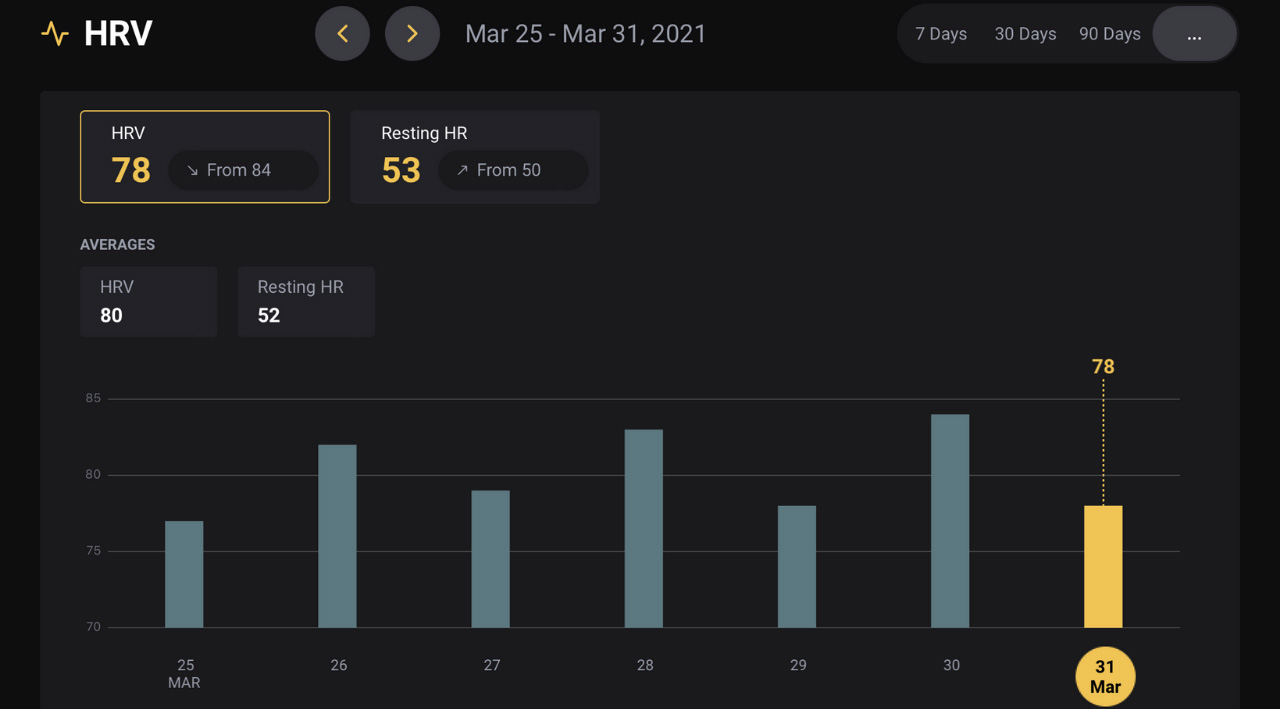
When you see this type of HRV pattern, it means that adding even more stress on top of it through another hard workout is just going to slow down the recovery process.
Again, that doesn’t mean your body isn’t capable of a hard workout.
But it does mean that you’ll pay a higher cost for that hard workout and that’s something you need to factor into your decision making process.
Using a pre-workout screen to keep your conditioning on track
As part of that process, I suggest asking yourself the following four questions to help you get your training dialed in each day:
- What do I have planned for today?
- Where is my HRV today?
- Where has it been the last 2-3 days?
- What do I have planned for tomorrow?
If your HRV is only slightly higher or lower than normal today, but it’s looked good the last 2-3 days and you have a day off tomorrow, for example, that means you can probably dial up whatever level of intensity you had planned.
If your HRV is much higher or lower than normal, it’s been off the last couple of days and it’s only a Tuesday, however, then that’s a different story.
In that case, avoiding a high-stress workout is probably the smarter way to go.
A big thing to keep in mind is that your underlying goal should be to choose the right level of intensity and volume every day so that you’re starting off each new week relatively well-recovered and ready to go.
Note: To learn more about how to structure your weekly program, you can click here to read this article and make sure to get on the early notification list for my upcoming Conditioning MasterProgram
This is a sign that you’re staying within the recovery limits of your body.
Over the long-run, this is the key to seeing long-term results and consistently reaching your goals.
If you push too hard and exceed your recovery limits, you’ll inevitably start carrying fatigue from one week to the next. Once that happens, it’s just a matter of time before you hit a plateau and/or start seeing nagging injuries.
The good news is that looking at your HRV and going through the pre-workout screen only takes a few extra seconds, but it can save you weeks, or even months, of wasted effort.
HRV can tell you whether or not all your hard work is paying off (without having to wait weeks or months)

Aside from using HRV to make smarter decisions each day about your training, you can also use it to make sure that those decisions are paying off and your conditioning is improving.
No matter what your goal is, nothing is worse than putting in the work, day after day, only to realize weeks (or months) later, that it didn’t pay off and you didn’t get any better.
This is especially true when it comes to conditioning because it takes a lot of time and effort to build it. It doesn’t happen overnight.
The problem has always been that it’s generally easier to measure progress in areas like strength or body composition than conditioning.
The weights you’re lifting either increase or they don’t.
To understand how HRV can help solve this problem, we have to consider what conditioning is (and what it isn’t).
In the simplest of terms, conditioning is the application of fitness to achieve a specific goal. That goal may be performing in a sport, living a healthier, longer life, or anything in between.
You can see the difference between fitness and conditioning below from an IG post I made awhile back (click here to follow me).
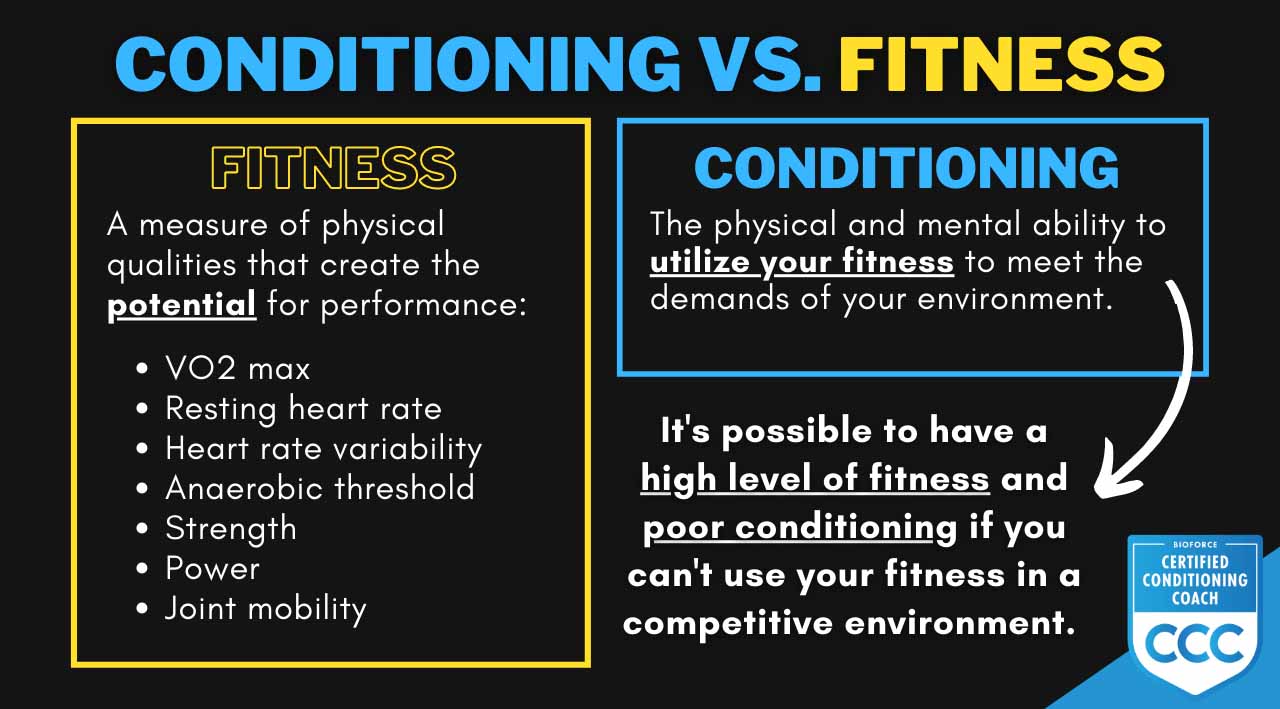
The reason HRV is a key fitness metric for just about any conditioning goal is because it’s closely correlated with two hugely important pieces of the performance puzzle: aerobic fitness and overall stress resilience.
Aside from a few pure strength/power sports like Weightlifting, shot put, etc., aerobic fitness is a major component of conditioning because it plays the biggest role in energy production.
It’s literally providing the majority of the fuel for performance, and life itself.
An easy way to understand this is that the more energy your body can produce aerobically, the less it will have to produce anaerobically and the longer you can go without fatigue.
By the same token, because aerobic fitness is what your body runs on 24/7, it’s what produces virtually all the energy your body uses to drive recovery. This means it also has a major impact on how much overall training (and life stress) your body can handle without breaking.
So although HRV can’t measure conditioning directly, it can give you a very good picture of whether or not your aerobic fitness is improving because the two are so closely connected—see the graph below.
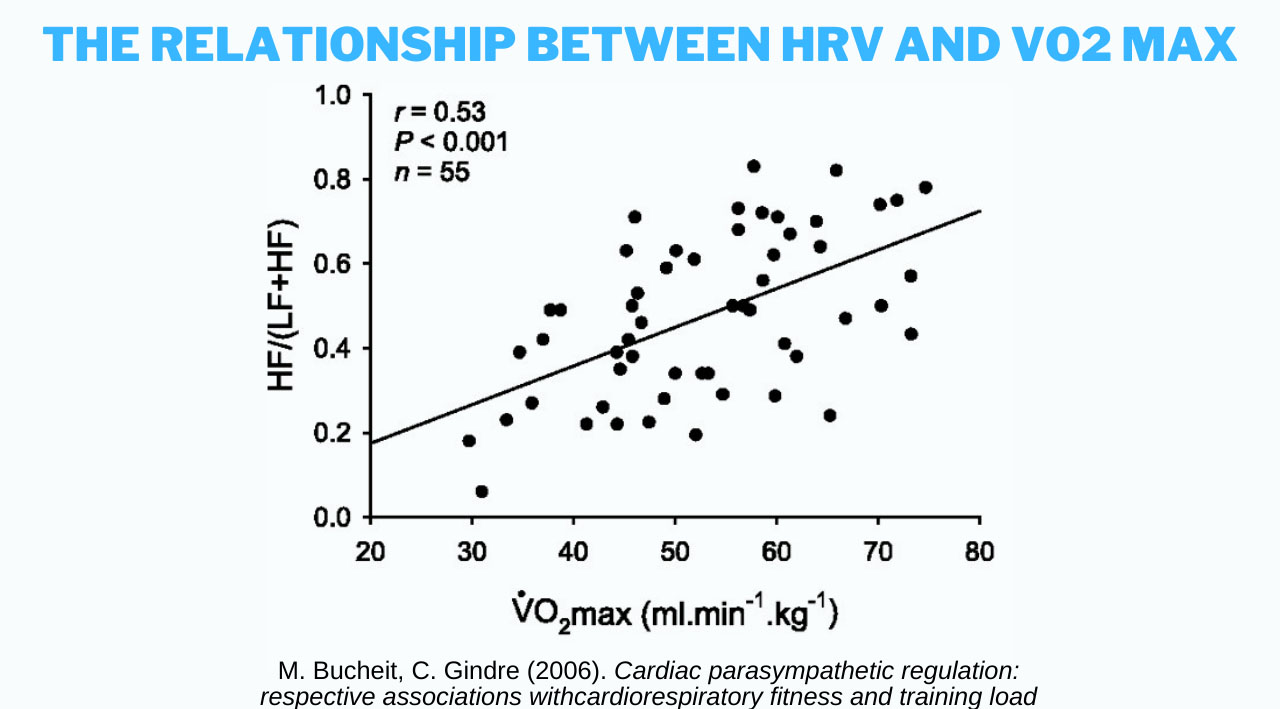
This connection means that you can zoom out and look at the overall trend of your HRV to make sure your conditioning is heading in the right direction or not.
And if it’s not, then it’s important to recognize this as quickly as possible so you can fix whatever is broken and holding you back.
While your HRV changes from day to day in response to stress, you should be able to see positive changes on a weekly and monthly basis.
The screenshot below is a great example of what it looks like when you train smart and make steady gains in HRV over a period of several months.
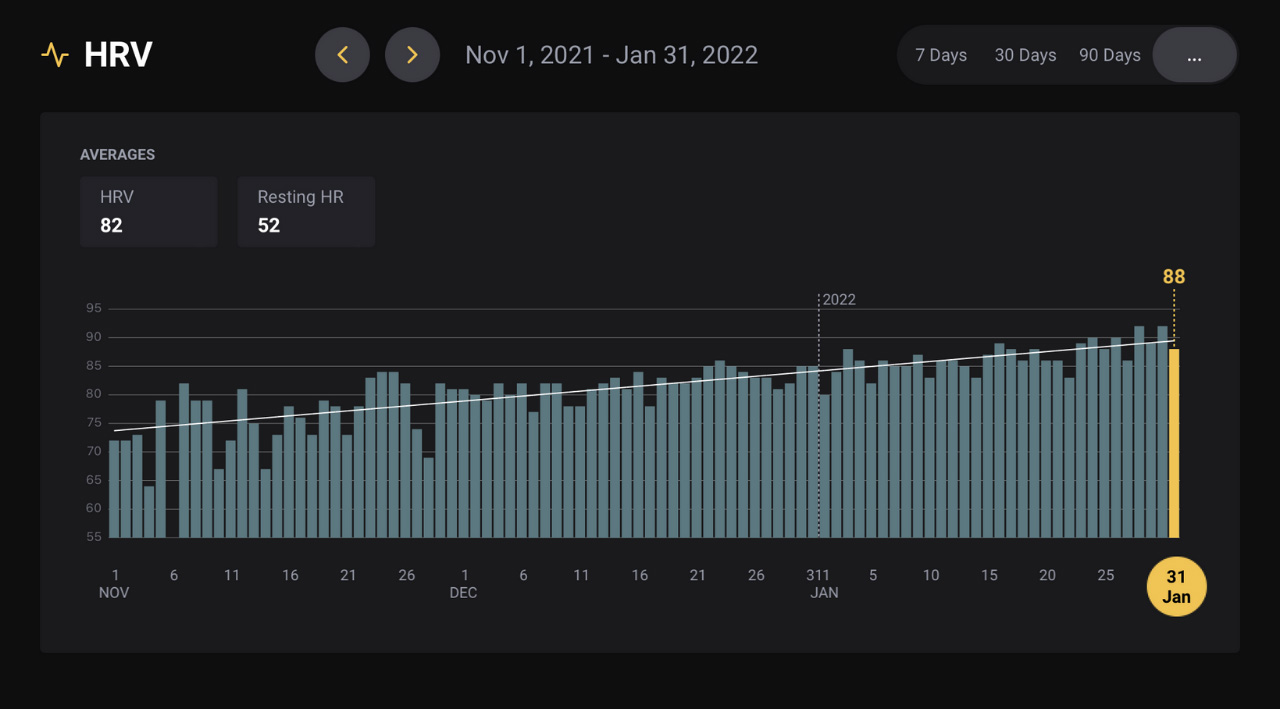
The big picture of improving your HRV (and conditioning)
In order to use the full potential of HRV to help you improve your conditioning, you have to know what trends to look for.
In other words, you need to know how to read the story that weekly and monthly changes in HRV are telling you.
The first part of this comes from understanding that how much your HRV will increase over time depends on your overall fitness level, how good your training program is, genetics, lifestyle, and more.
As with any other area of fitness, the lower your aerobic fitness and HRV are to start with, the easier they are to improve. Once you get to a certain level, progress slows down and it takes more time to see a noticeable increase.
A good general rule of thumb is that if your overall aerobic fitness and HRV are relatively low to start with, you should be able to see improvements on a weekly basis.
In other words, if you compare your average HRV from one week to the next, you should see increases more often than not.
If you’re already in good shape with reasonably high aerobic fitness and HRV, you will need to zoom out further and look at your average HRV from one month to the next to see improvements.
And if you’re at the top of your game and a high-level athlete, particularly an endurance athlete, you’ll likely need to look at 3-6 month periods to see what the trends are telling you.
The value of a weekly HRV review
Regardless of your fitness level, if your goal is to increase conditioning, I recommend doing a quick weekly HRV review.
Generally, this means each Monday, you look back at your HRV across the previous week. More often than not, you want to see it either increasing, or at least staying reasonably even.

While it’s normal to occasionally see weeks where your HRV decreases, particularly during a heavy phase of training or during a period of a lot of lifestyle stress, it’s important to prevent this from happening too often.
If you’re consistently seeing your HRV increase or go up during each review, you’re on the right track. Keep it up.
If it’s never increasing or it’s consistently going down, it’s a good sign that you’re on a sinking ship and you need to get off before you drown.
It’s this ability for HRV to help you recognize that you’re not headed in the right direction before you’ve wasted a ton of time that makes it so valuable.
This gives you an opportunity to dig in, figure out why you’re not improving, and then fix whatever is broken.
Taking a few minutes a week to do a quick review of HRV over the last week can save you a ton of time and frustration and make sure your efforts will ultimately pay off with better conditioning.
What to do next
If you’re already tracking your HRV, adding a quick daily and weekly check of your numbers to understand the story of your body’s stress and recovery is the easiest way to make sure you’re using it effectively to improve your conditioning.
Even if your goal isn’t to improve conditioning, but another area of fitness, the same HRV strategies apply.
You shouldn’t expect to see your HRV increasing if you’re not trying to improve aerobic fitness, but at the very least, the goal should be to maintain what you already have and make sure you’re not spiraling towards overtraining.
If you aren’t tracking your HRV yet, make sure to check out my Morpheus system by clicking here.
I designed it to give you the most complete picture of training and recovery possible by taking everything into account – from HRV, to sleep, activity, training, and more – and then helping you understand how to turn those numbers into smarter training and faster recovery.
If you need a conditioning program, make sure to jump on the early notification list for my upcoming MetaMorphosis Conditioning MasterProgram.
I’ll be opening the doors on April 12th, and it’s built on the same principles I’ve used to train some of the world’s best conditioned athletes over the last 20 years. You don’t want to miss this one!
